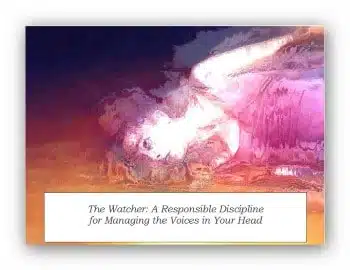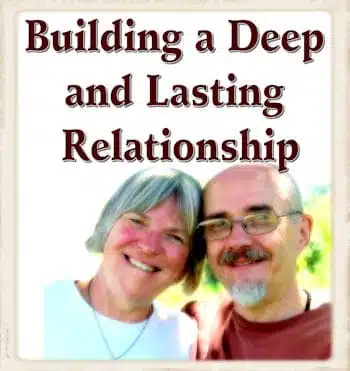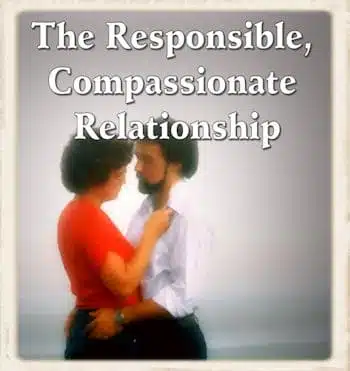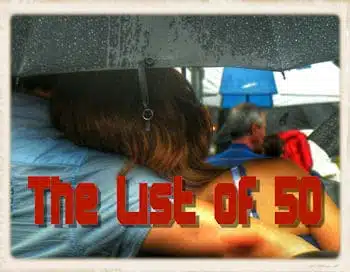Check back here regularly!
We’re adding in Free and almost free resources, like booklets. Probably other stuff too!
The Watcher

A booklet that describes a way out of the nattering and judgements that go on in our heads.
By learning to use “The Watcher,” we move from living on auto- pilot to having choice.
A great tool for learning from your emotions while not being led around by them.
Select one or more:
–> Read a Sample
–> Read Reviews
Introduction
Many years ago, I had a mood shift that lasted for 5 hours. It was one in a long series of depressive episodes, something that began when I was in College. The longest was 5 months.
I decided way back then to use myself as a Guinea-pig and see if I could both analyse and shift the internal process I was engaging in. I’m not a fan of drugs, so I had a lot invested in coming up with a way of managing these episodes using focused attention.
Given this booklet, I came up with a strategy for “managing the voices in my head,” aka The Watcher.
We all talk to ourselves, all the time, and part of that internal dialogue seems hellbent on creating misery. We listen to our stories, make ourselves miserable, and then make ourselves more miserable that we are miserable!
The Watcher is a head game designed to help you to see how you talk to yourself. The Watcher is a way out of this self-defeating loop.
FIRST, THOUGH, A DISCLAIMER. I AM NOT, FOR A MOMENT, SUGGESTING THAT YOU SELF-DIAGNOSE AND SELF-TREAT DEPRESSION. INDEED, AS YOU EXPLORE LEARNING MORE ABOUT YOURSELF, YOUR MOODS, EMOTIONS AND SELF-TALK, A PROFESSIONAL COUNSELLOR OR THERAPIST IS THE BEST IDEA GOING. PART OF THE PROCESS OF SELF-EXPLORATION — THE ESSENTIAL INGREDIENT, IN MY VIEW, IS THE PRESENCE OF AND INTERACTION WITH AN OBSERVER OR WITNESS WHO CAN HELP GUIDE THE PROCESS. THIS BOOKLET IS INTENDED AS A GUIDELINE AND AS AN ALTERNATIVE APPROACH TO LIFE AND TO THE EMOTIONS. HOW YOU CHOOSE TO USE THIS INFORMATION IS SOLELY YOUR RESPONSIBILITY.
So, let me tell you about my first and only major depression. It began in the late summer of 1978. I had just been let go from a job-one I disliked but which was paying my way, and I decided to take a few days off to think and to do some photography. During College, I’d been a commercial photographer-advertising, mostly-and I’d opened a photo studio for a year or so when I first moved to Canada.
I decided to go off to Algonquin Park in the near north of Ontario, backpack into the park and take a pile of pictures.
I went in May. There was, back then, a lot of snow in Algonquin in May. Being from somewhat sunnier climes, I hadn’t anticipated that. I wasn’t prepared, clothes wise, equipment wise or emotionally, for 5 days in the snow. I did it anyway. (As those of you who know me start laughing and say, “Of course he did!”)
I froze my butt off, took lousy pictures and sat at my fire each night, chain smoking my pipe (1978, remember) while quietly and thoroughly taking myself apart. I managed to do such a thorough job of self-hate that by the end of the 5 days, my spirit had fled and I was in the dumper. I got home, processed the rolls of film, confirmed my premonition that the pictures would suck, and promptly sat down in my green leather reclining chair, vowing to stay there until I died.
Each day I would leave my bed and go to my chair. I’d drink Pepsi, watch tv and stare out the window. My wife (ex-wife since the early 80’s) would hand me food and I would eat. I survived somehow, but the days were endless, bleak, and black.
I climbed out of the chair and the depression in September when I started attending a seminary in Toronto. That experience led to my getting my Masters in Counselling in ’83, and establishing The Phoenix Centre for Creative Living.
Since 1978, I have had several episodes of depressive feelings, none lasting longer than a day or two, most measured in hours. I’ve never taken drugs for any of this, and I believe that my path out of this loop was in my exploration of my internal theatre. I have become increasingly convinced that wisdom comes as we understand and have compassion for this inner realm.
Many clients came to me hoping that I could somehow take away their pain. They want to stop hurting-to stop hurting themselves-to be happy. They assumed everyone else on the planet was happy, and that they were doing something wrong. They blamed their parents, their partner, their kids-and most of all they blamed themselves.
They told me how difficult, if not impossible, it was to change. They told me that they’d tried, really tried, to change.
They were definitely not pleased when I said that they could not change-that all they could do was to make other choices-they could learn to expand their repertoire.
Wait a minute! What do you mean I can’t change!
What a useless booklet!
Well, hang on a minute.
Keep reading. What I’m saying will become increasingly clear as the pages go by. For now, however, here’s a hint: Who we are at our cores is hard wired in. For example, my depressive nature, as well as my infamous temper, was, is and always will be a part of me.
It used to be that I thought I simply got depressed (sort of like one catches a cold-it happened to me.)
Back before 1982, when my supervisor gave me an assignment-choose!-I’d have told you there was absolutely nothing I could do to control my temper and my tongue.
Thanks to implementing her suggestion, I learned several things:
1. my temper and my moods are as much a part of me as my beautiful, deep blue eyes.
2. What I choose to do with my moods and my temper depends on the breadth of my belief system and my willingness to challenge my self-perception.
3. And emphatically, choosing differently is about the amount of self-discipline I am willing to exert.
Because, even in the year 2016, with decades of practice, it is easier for me to get depressed than to have the self-discipline to follow the process of working through the depression.
Or the anger. Or the self-doubts. Or the self-criticism.
Or whatever game I choose to play out.
So, that’s a bit of the back story to this booklet. Now, let’s have a look at how all of this is set into motion, and look at alternatives. Relax and come along for the ride.
What people are saying about “The Watcher”:
- Just read the Watcher — great writing — great food for thought — Mary
- Loved the Watcher. It is oh so true and a lifelong battle I believe to keep
these voices from running our lives. Sometimes when my voice starts nagging at me, I tell it to shut up right out loud! Makes me feel better, but I don’t do it
too often in crowded rooms. Marilyn
Learn to manage the voices in your head by establishing an “Observer / Coach” persona. This booklet provides practical lessons for learning to be in charge of your inner theatre. An excellent resource if you’re dealing with depression.
You can have this booklet for .99, instead of 4.99!
Building a Deep and Lasting Relationship

A FREE 45 page booklet on relationships, including discussions about forming healthy, communication based pairings. There are questionnaires, suggestions and stories galore.
Select one or more:
–> Read a Sample
–> Read Reviews
Introduction
A couple was in my office the other day… young folk, together two years, and the passion, sexual play and fun had escaped from their marriage. The woman said: “He lied to me. When we started dating, he hugged me and kissed me and wanted sex all the time. Now, he never tells me he loves me, won’t hug or kiss me, and most of the time he’s not interested in sex.”
I asked her how she felt. She indicated that she felt angry, thinking she was cheated and unloved. She told me that her response to these feelings was to refuse sex when he did get around to asking, an interesting form of punishment quaintly known as “Cutting off one’s nose to spite one’s face.”
I then asked the man for his version of all of this. He replied: “I grew up in a home where you didn’t touch or tell people you love them. I come home every night. I bring her my pay cheques. I don’t gamble or fool around. That should be enough for her to know that I love her. I don’t mind if she hugs me or kisses me, but I forget to do it to her. I’d really rather watch the Blue Jays.”
I asked him about her recollections about their early dating days. “She’s right,” he replied. “I did do all of those things in the beginning. I wanted her to like me. Once I got her, I figured I could go back to being who I really am.”
Hopeless, right? I think not. But quite typical, really. Many of our expectations of whom our partners should be come from two strange areas: 1) they come from how the person behaved during the first several months of the relationship, and 2) they come from our fantasies of how we imagine our partner should behave.
Strange ideas one and two deny two truths:
1) People are who they really are, and
2) everything in life, including people, change.
What we fantasize to be true often isn’t. What is real is what is real today.
We can’t go back to the beginning of your relationship and try to find a way to convince you to be honest with your partner. I wish we could. If everyone had the courage to state, loudly and clearly, who they are and what they know of their true nature, a lot of confusion and anger could be avoided later on.
As I work with couples, I’m struck by how differently the two people perceive the world. There are reasons for this discrepancy:
-
The profound differences in world view that are unique to one’s gender.
-
The understanding that people are the total of their experiences, and no two people have had the same experiences.
-
The impact that results from the kind of parenting each person received.
Experiences, upbringing and gender all impact to make people who they are at the core of their being.
What people are saying about “Building Deep and Lasting Relationships”:
- Your booklet was very insightful. Certainly one I will keep in the archives for future reference when things get confused!!
- It is really very thought provoking. I gave my roommate the brochure that I printed out to read. She is in a relationship with someone right now, and I thought that it might be helpful for her. Their relationship has progressed very rapidly… almost too rapidly. But recently she has been having some doubts about where they are headed. As she started reading, she looked at me with tears in her eyes and said, “This is wonderful.” She now wants her gentleman friend to read it also, and to work through some of their “problems” using your techniques.
- Thank you very much for the relationships booklet. Very solid counseling. I am re- reading it and working on it!
- I felt this booklet was incredibly insightful. I know that I will need to read it over again to gain the most from it. I believe it will help me in many aspects of my life … Thank you for making something so beneficial available.
You can have this booklet for FREE!
Just put 0.00 in the price box.
HOWEVER, if you’d like to support our work, writings, and effort, please feel free to pay what you think is fair. Thanks!
The Responsible, Compassionate Relationship

A FREE 36 page booklet on building the most deep and meaningful relationship possible. You’ll find encouragement for finding a depth of meaning as you learn about yourself and share it, intimately and clearly, with your partner.
Select:
–> Read a Sample
Introduction
It’s time to look more deeply at establishing a highly functional relationship, which I call the compassionate, responsible relationship. Now, the first and most obvious question is, “compassionate for whom?” and “responsible for what?”
The answers:
Compassion: For yourself. For your partner. On average, in balance. Without compromise.
Responsible: For yourself. For your behaviour and for meeting your needs. Without manipulation. Without compromise.
That should effectively eliminate 90% of all relationships out there. Those relationships are based upon winning, being declared right, or “teaching my spouse” all the things she or he is too stupid to figure out for him/herself.
As you’ve likely noticed, I am an advocate for being a responsible adult. As such, I am responsible, totally, for what I feel, what I do, how I act and how I choose to relate. As a responsible adult,
I am not genetically predisposed to be a jerk, although that may be how my parents behaved toward each other.
I am not the victim of others, who I judge are out to get me, despite the fact that some people may not like me or have used their influence to attempt to hurt me.
I am not the wise and all-knowing person who, by force of will, persuades others of the error of their ways, using sarcasm, “logic” or nattering to change their minds.
As a responsible adult, I have the choice, always, to deepen my relationship, or to alienate myself from my partner. And all of this, no matter what my partner is doing.
Now, if it appears, on the surface, like a responsible, compassionate relationship is an impossibility, let me assure you that it is not. Nor, on the other hand, is it easy.
Easy is falling into the same old bad habits you’ve always fallen into.
Easy is blaming, rolling around in the mud, using guilt as a weapon.
Easy are all of the manipulative behaviours we discussed in the ” Relationships” booklet.
Interestingly, were you to put this booklet aside and simply make use of what you’ve learned in the first two booklets, you would have a successful relationship. I call this “Level One change.”
You would be able to identify the patterns of behaviour that get you and keep you stuck.
You would be speaking in “I” language.
You would be identifying what you need and asking for it.
You would be learning to discuss issues through to conclusion rather than simply fighting to win.
The next level of relationships (“Level Two change”) is “where the action is.” At the level of a responsible, compassionate relationship, we enter into a bond with another person, and that bond is designed, as Scott Peck once put it, to allow each person to actively participate in the Spiritual growth of another person.
I unpack Peck’s language to mean that, in my relationship with Dar, we have in each other a witness for what we are learning about ourselves. This “witnessing” is a participation, through dialogue, in the depth work (soul work) each of us is undertaking. Our loving for each other is somehow mysteriously tied up in our willingness to enter into the depths of ourselves, and then to reveal what we find to each other – both the mundane and the significant. And this witnessing involves a commitment to comment on Dar’s process, and vice versa.
For example, I used to have a doom and gloom scenario that would play in my head, concerning money. As in, we don’t have enough, I’m not working hard enough (despite 10 hour days 7 days a week … ) I should stop counselling and get a “real” job, etc., etc., etc. At the heart of this scenario is my deep belief that worth is measured in work – that if I never stop, I must be valuable. It is only in the last two months that I have chosen to dismantle this belief, slow down and begin to notice who I am at this stage in my walk. Needless to say, I have shared my interior theater with Dar for some years now.
I suspect that Dar has listened to my fears and doom and gloom scenarios once per month for 16 years. I hold this up as a shining example of her patience, as she waited for me to work my way through this self-created dilemma. (Please note, by the bye, that my language in describing the above was “I” language; I’m emphatically not blaming Dar for my internal drama. Dar listens, nods sympathetically, encourages me to tell her more, and after five minutes, I wind down and get over myself.) Because of our disciplined process, we have been able to listen to each other over the years, offer support and encouragement for continued exploration – and we’ve reaped the benefits when we’ve reached clarity regarding our issues.
Contrast that with the case study that begins the next chapter. Happy reading, and if you like this booklet, tell a friend!
You can have this booklet for FREE!
Just put 0.00 in the price box.
HOWEVER, if you’d like to support our work, writings, and effort, please feel free to pay what you think is fair. Thanks!
The List of 50

A FREE booklet on finding your life partner (and finding friends you can be friends with for life!) This booklet is for people who are looking to establish a conscious, thoughtful relationship, without any of the drama of prior relationships.
Select one or more:
–> Read a Sample
–> Read Reviews
This booklet follows hot on the heels of “Building Deep and Lasting Relationships,” a source book(let) for the foundations of powerful relationships. In keeping with Star Wars, Episode 1, this booklet is sort of a prequel. The next volume will pick up where Relationships left off and will describe compassionate relationships.
“The List of 50” is a code I use for a project I suggest to clients. Often, following a marriage break-up or a relationship ending, my clients will make two assumptions:
- “I’ll never meet anyone, ever again,” and
- “If I do meet someone, I’m doomed to repeat the mistakes I made the last time.”
Against that background I developed the concept of The List of 50.
You’ll remember from “Relationships” that I talked a bit about sexual attraction being the “thing” that gets most relationships going. Equally applying to both men and women, there is an initial meeting of the hormones. Without that initial attraction, it is the rare couple indeed that gets together. (If you haven’t read our free booklet, “Building Deep and Lasting Relationships,” you should download it from our web site.)
Most relationships begin, then, as observation leading to hormones leading to dating. Initially, there is little thought about the character, focus, direction and life purpose of our “intended.” Indeed, if we consider who the person “is” at all, it is at the level of thinking that any “personality quirks” that turn up can be fixed by asking the person to change. To recap, it’s almost as if we’re saying to ourselves: “Wow, she’s cute. I really like her. I think I’ll ask her out. If there are other things about her I don’t like, she’ll change because she’ll love me” And thus the dance begins.
In the early dating stage, we are on best behaviour. We read the other carefully, for signs, for hints, as to what they want. We attempt to become that kind of person, to provide for their needs, even if it flies in the face of whom we actually are. After six months, the veneer begins to wear off. We start acting more normal; so does our partner. At this point, there is a rush of disappointment. A sense of being lied to. But another dumb little voice kicks in and says, “Oh well, I’ve got six months invested in this relationship, and I may never get another chance, so I’m going to stick around anyway, and just try harder to change him.”
From that point on, until they wise up and cut it out, there will be a battle, by one or both persons, to change the other person, to get the other person to behave, to force the other person to be someone they are not. As this battle is a no-win situation, most relationships continue, forever, to be a battle. Or, the parties give up and become apathetic. Or, the partners split.
I spend a lot of time with couples who have followed pretty much this course, and end up in my office, not at the first hint of trouble, but years into the relationship, looking for a way to stop fighting. It is possible to help such couples to learn to respect each other as persons, and to teach them the techniques and reasons for excellent communication (as we discussed in “Relationships,”) but the underlying edge, for most of these couples, is this: “This is not the person I should be in relationship with. I love her, but I don’t particularly like her. I’m doing this to stop the fighting, make the best of the situation and gain some energy to get on with the rest of my life.” This is a worthwhile and achievable goal.
(Actually, I suspect that more than “making the best of the situation” is possible, and I’ll discuss that in the third volume of this series of booklets. I’m projecting mid October 1999 for release.)
However, I couldn’t help but think that there had to be a way to do all of this differently, especially if I was dealing with a person prior to forming a relationship, or from the place between relationships. I reasoned that hormones will always be with us and will act as a determinant for the kind of people to whom we are attracted. But what, I wondered, would happen if people were intentional about thinking about whom to be in relationship with? What if they decided, in advance, about the communication style they wanted to have, the life focus and direction their partner would work from?
Let me stick in a caveat here: I’m NOT proposing trying to find clones of ourselves. You know, the New Age “Oh God, I’ve found my soul mate” bit. “He thinks like me, with both love tofu, he completes my sentences … yada, yada, yada.” This is about finding the kind of person I would choose to be in challenging, growthful dialogue with for the rest of my life.
I decided to write this booklet for those of you who are “still looking.” What came to me, way back when, was: we get into weird relationships is because we don’t know, have never thought about, what characteristics we are looking for in a partner. We thus meet the people we eventually partner with totally by chance. I developed The List of 50 to counteract our reluctance to think about relationships. After years of working with this technique, both personally and with my clients, I have seen impressive results. I now share this concept with you.
In the next chapter, I want to tell you my personal experience with this idea. From there, we’ll move to other examples, and finally the meat of creating the list — and what you do with it. Lastly, we’ll talk about an extra benefit of the list — using the list also gets you the friends you’re seeking.
Let’s get to it.
What people are saying about “THe List of 50”:
You may not recall, but I met you once a couple of years ago
while attending a session with [a client of yours who is a friend of mine] as a quiet witness of your Bodywork. It was quite an intense session, and I was very honoured that she asked me to attend and that you didn’t mind my presence. One activity she has shared with me is the infamous List of Fifty. This act of positively exploring my needs and desires was very rewarding. I have shared this idea with many of my friends and family, with many positive results and constructive conversations.
Not surprisingly, this List was a key component in discovering that the person I wished to share my life with was in fact a very close friend of mine. He too completed a list of fifty, and through some soul searching we realized that we were looking for each other. Though neither of us had considered the act of marriage before, the idea of creating a symbolic union naturally appealed to us.
Another wrote:
My friend/professor told me about this and says it has changed her outlook and relationships. An interesting perspective that I would like to read about.
You can have this booklet for FREE!
Just put 0.00 in the price box.
HOWEVER, if you’d like to support our work, writings, and effort, please feel free to pay what you think is fair. Thanks!
